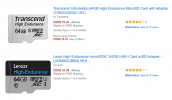This white paper from Samsung refers to V-NAND and MLC in the same context - ie this tested V-NAND MLC:
http://www.samsung.com/us/business/oem-solutions/pdfs/V-NAND_technology_WP.pdf
They're certainly comparing it to MLC planar/2D NAND, and using it as short-hand for 2bit V-NAND. You'll notice that they only use the MLC short-hand in the charts. In the actual writing they refer to it more correctly as "2bit" and "3bit" V-NAND, though as primarily a technical marketing document toward SSD manufacturers, they don't really delve into any depth on that difference. Regardless, that's not the unsupported misinformation that
@Nigel was spreading while baiting with the following claim: "Samsung have two types of 3D NAND, their Evo range uses TLC cells and their Pro range uses MLC cells, just like their planar NAND chips."
I've just seen the price of those 256GB Samsung microSD cards - jeez!
No joke. That's why I'm said if they can get to the point where it's more affordable then I don't see why it wouldn't take over as the go-to option for dashcams. The problem is that neither on the product page nor in their
press release from May 2016 does Samsung specify whether the V-NAND they're using in their 256GB EVO+ microSD cards is 2bit or 3bit V-NAND. So it's hard to know for sure what their strategy is. Maybe it's 2bit and therefore they can improve in the future with 3bit to bring costs down. I doubt it, though, or else they'd be bragging about that, too, as they would for SSD's. I imagine it's most likely already 3bit, which won't have quite the inherent major endurance advantage over MLC planar NAND, which may explain why they're still voiding/limiting the warranty when used in dashcams. If so, only time will tell how the endurance really is and whether the warranty will even be a concern. With such large capacities it should really cut down on the number of writes, and even if the endurance is cut in half, it should still be at least comparable to MLC (planar NAND) and maybe still be superior.
In the meantime it still doesn't seem to be legitimately available on Amazon, leaving you with a $250 price tag if you try to
order it directly from Samsung. So someone like me will have to go ahead and wait for availability to increase and price to decrease.

